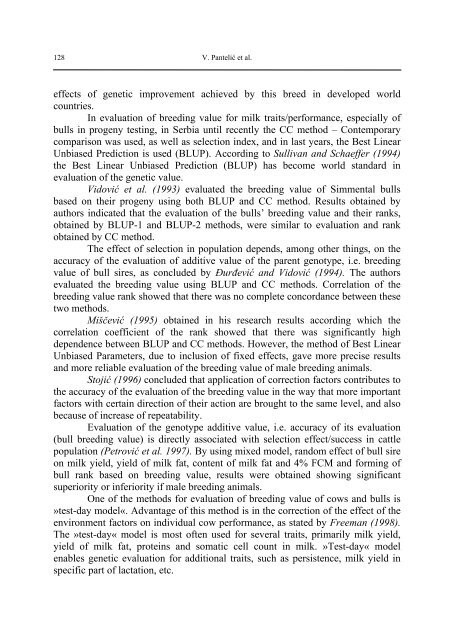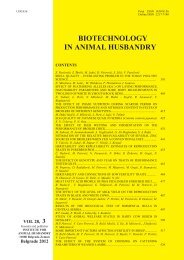Biotechnology in Animal Husbandry - Institut za Stočarstvo
Biotechnology in Animal Husbandry - Institut za Stočarstvo
Biotechnology in Animal Husbandry - Institut za Stočarstvo
Create successful ePaper yourself
Turn your PDF publications into a flip-book with our unique Google optimized e-Paper software.
128<br />
V. Pantelić et al.<br />
effects of genetic improvement achieved by this breed <strong>in</strong> developed world<br />
countries.<br />
In evaluation of breed<strong>in</strong>g value for milk traits/performance, especially of<br />
bulls <strong>in</strong> progeny test<strong>in</strong>g, <strong>in</strong> Serbia until recently the CC method – Contemporary<br />
comparison was used, as well as selection <strong>in</strong>dex, and <strong>in</strong> last years, the Best L<strong>in</strong>ear<br />
Unbiased Prediction is used (BLUP). Accord<strong>in</strong>g to Sullivan and Schaeffer (1994)<br />
the Best L<strong>in</strong>ear Unbiased Prediction (BLUP) has become world standard <strong>in</strong><br />
evaluation of the genetic value.<br />
Vidović et al. (1993) evaluated the breed<strong>in</strong>g value of Simmental bulls<br />
based on their progeny us<strong>in</strong>g both BLUP and CC method. Results obta<strong>in</strong>ed by<br />
authors <strong>in</strong>dicated that the evaluation of the bulls’ breed<strong>in</strong>g value and their ranks,<br />
obta<strong>in</strong>ed by BLUP-1 and BLUP-2 methods, were similar to evaluation and rank<br />
obta<strong>in</strong>ed by CC method.<br />
The effect of selection <strong>in</strong> population depends, among other th<strong>in</strong>gs, on the<br />
accuracy of the evaluation of additive value of the parent genotype, i.e. breed<strong>in</strong>g<br />
value of bull sires, as concluded by Đurđević and Vidović (1994). The authors<br />
evaluated the breed<strong>in</strong>g value us<strong>in</strong>g BLUP and CC methods. Correlation of the<br />
breed<strong>in</strong>g value rank showed that there was no complete concordance between these<br />
two methods.<br />
Miščević (1995) obta<strong>in</strong>ed <strong>in</strong> his research results accord<strong>in</strong>g which the<br />
correlation coefficient of the rank showed that there was significantly high<br />
dependence between BLUP and CC methods. However, the method of Best L<strong>in</strong>ear<br />
Unbiased Parameters, due to <strong>in</strong>clusion of fixed effects, gave more precise results<br />
and more reliable evaluation of the breed<strong>in</strong>g value of male breed<strong>in</strong>g animals.<br />
Stojić (1996) concluded that application of correction factors contributes to<br />
the accuracy of the evaluation of the breed<strong>in</strong>g value <strong>in</strong> the way that more important<br />
factors with certa<strong>in</strong> direction of their action are brought to the same level, and also<br />
because of <strong>in</strong>crease of repeatability.<br />
Evaluation of the genotype additive value, i.e. accuracy of its evaluation<br />
(bull breed<strong>in</strong>g value) is directly associated with selection effect/success <strong>in</strong> cattle<br />
population (Petrović et al. 1997). By us<strong>in</strong>g mixed model, random effect of bull sire<br />
on milk yield, yield of milk fat, content of milk fat and 4% FCM and form<strong>in</strong>g of<br />
bull rank based on breed<strong>in</strong>g value, results were obta<strong>in</strong>ed show<strong>in</strong>g significant<br />
superiority or <strong>in</strong>feriority if male breed<strong>in</strong>g animals.<br />
One of the methods for evaluation of breed<strong>in</strong>g value of cows and bulls is<br />
»test-day model«. Advantage of this method is <strong>in</strong> the correction of the effect of the<br />
environment factors on <strong>in</strong>dividual cow performance, as stated by Freeman (1998).<br />
The »test-day« model is most often used for several traits, primarily milk yield,<br />
yield of milk fat, prote<strong>in</strong>s and somatic cell count <strong>in</strong> milk. »Test-day« model<br />
enables genetic evaluation for additional traits, such as persistence, milk yield <strong>in</strong><br />
specific part of lactation, etc.




